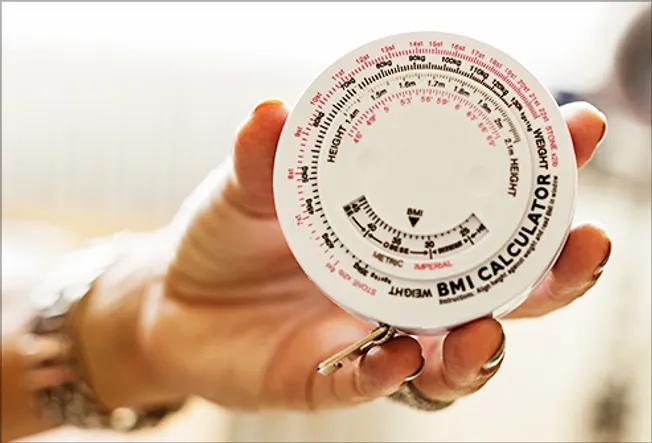Current BMI tests underestimate obesity in teens with disabilities
New approaches, based on body mass index (BMI) or other simple measures, are needed to improve assessment of obesity in adolescents with physical disabilities, reports a paper in the American Journal of Physical Medicine & Rehabilitation, the official journal of the Association of Academic Physiatrists. The journal is published by Wolters Kluwer.
Obesity is a major problem in children and adolescents with mobility limitations, but standard assessments tend to underestimate it, according to the new research by Brooks C. Wingo, PhD, of University of Alabama at Birmingham and colleagues. They suggest new cutoff points are needed for identifying disabled teens who may need diagnosis and treatment to prevent health and functional problems due to excess body weight.
What’s the Best Measure to Assess Obesity in Disabled Teens?
The study included 29 adolescents (average age 16) who had spinal cord injury or other types of physical disability and used a wheelchair to get around. The researchers assessed various clinical indicators of body weight - not only BMI (calculated from height and weight), but also the width of a skinfold pinched in the upper arm (triceps) and circumferences of the waist, arm, and leg.
In addition, a procedure called dual-energy X-ray absorptiometry (DXA) was done to measure the patients’ percentage of body fat. Obesity was defined as 30 percent or greater body fat for males and 35 percent or greater for females. The various clinical measures were evaluated as indicators of obesity, as objectively determined by DXA.
As in previous studies, many of the teens with physical disability were obese. Thirty-five percent of boys and 58 percent of girls met the DXA criteria points for obesity.
 However, if assessed by BMI alone, many of the patients would be misclassified as non-obese. Based on the standard BMI cutoff point of 95th percentile or higher for their age, only six percent of boys and 42 percent of girls were classified as obese. (Because they are still growing, the adult BMI cutoff point of 30 or higher isn’t appropriate for assessing obesity for children and adolescents.)
However, if assessed by BMI alone, many of the patients would be misclassified as non-obese. Based on the standard BMI cutoff point of 95th percentile or higher for their age, only six percent of boys and 42 percent of girls were classified as obese. (Because they are still growing, the adult BMI cutoff point of 30 or higher isn’t appropriate for assessing obesity for children and adolescents.)
All of the clinical measures were significantly correlated with body fat among the teens with disabilities. The best-performing measure was BMI, using a cutoff point of 20 for boys and 19 for girls. The second-best measure was waist circumference, with cutoff points of 83 centimeters (about 33 inches) for boys and 78 centimeters (about 31 inches) for girls.
Children and adolescents with physical disabilities are at high risk for obesity. In addition to health issues such as diabetes and heart disease, obesity puts disabled youth at risk of a wide range of other problems, such as pain and depression, and may further limit their independence and mobility.
But it can be challenging to assess obesity and overweight in people with disabilities, and especially in children and adolescents. While DXA is a more reliable test for measuring body fat, it’s not practical for everyday clinical use.
The exploratory study confirms that current cutoff points underestimate obesity in adolescents with physical disabilities. It also provides a first step toward developing alternative assessments of obesity in this group of patients, although further research will be needed to confirm and validate the proposed alternative measures. Dr. Wingo and coauthors also call for the development of disability-specific cutoff points, “which will allow clinicians to better identify children at risk of adiposity-related diseases and offer parents preventive strategies to improve the health and quality of life of their children.”
###
Click here to read “Exploratory Study Examining Clinical Measures of Adiposity Risk for Predicting Obesity in Adolescents with Physical Disabilities.”
Article: “Exploratory Study Examining Clinical Measures of Adiposity Risk for Predicting Obesity in Adolescents with Physical Disabilities” (doi: 10.1097/PHM.0000000000000323)
About AJPM&R
American Journal of Physical Medicine & Rehabilitation focuses on the practice, research and educational aspects of physical medicine and rehabilitation. Monthly issues keep physiatrists up-to-date on the optimal functional restoration of patients with disabilities, physical treatment of neuromuscular impairments, the development of new rehabilitative technologies, and the use of electrodiagnostic studies. The Journal publishes cutting-edge basic and clinical research, clinical case reports and in-depth topical reviews of interest to rehabilitation professionals.
About the Association of Academic Physiatrists
The Association of Academic Physiatrists (AAP) was founded in 1967 to serve as the national organization of physiatrists who are affiliated with medical schools. The AAP is a member organization of the Association of American Medical Colleges (AAMC). The AAP is the only academic association dedicated to the specialty of physical medicine and rehabilitation (PM&R) in the world. The mission of the Association is creating the future of academic physiatry through mentorship, leadership, and discovery.
About Wolters Kluwer
Wolters Kluwer is a global leader in professional information services. Professionals in the areas of legal, business, tax, accounting, finance, audit, risk, compliance and healthcare rely on Wolters Kluwer’s market leading information-enabled tools and software solutions to manage their business efficiently, deliver results to their clients, and succeed in an ever more dynamic world.
Wolters Kluwer reported 2014 annual revenues of £3.7 billion. The group serves customers in over 170 countries, and employs over 19,000 people worldwide. The company is headquartered in Alphen aan den Rijn, the Netherlands. Wolters Kluwer shares are listed on NYSE Euronext Amsterdam (WKL) and are included in the AEX and Euronext 100 indices. Wolters Kluwer has a sponsored Level 1 American Depositary Receipt program. The ADRs are traded on the over-the-counter market in the U.S. (WTKWY).
###
Connie Hughes
Connie.Hughes@wolterskluwer.com
646-674-6348
Wolters Kluwer Health